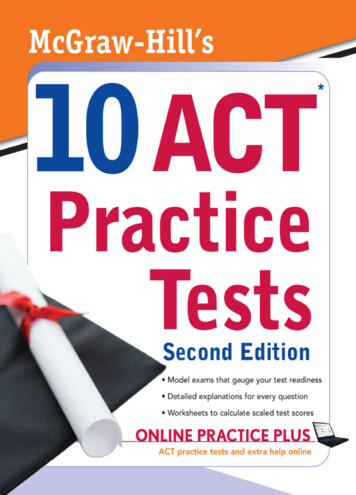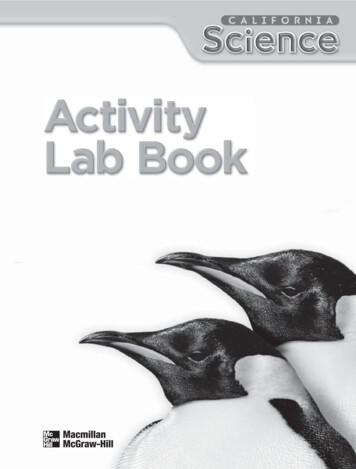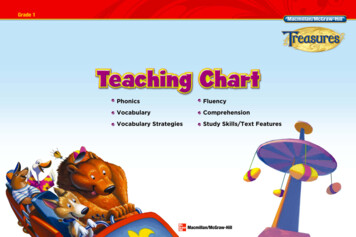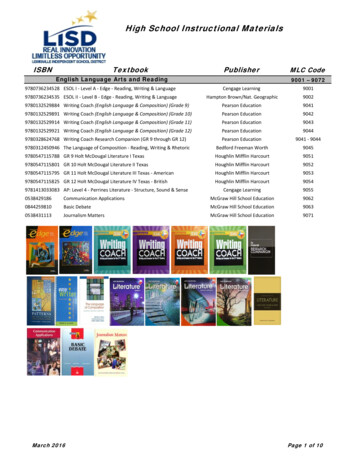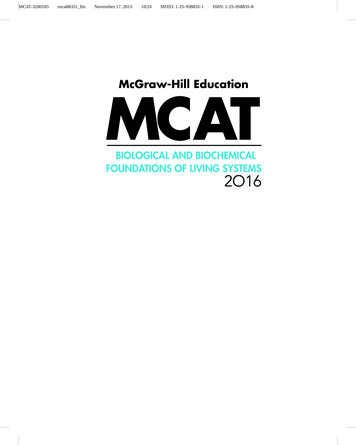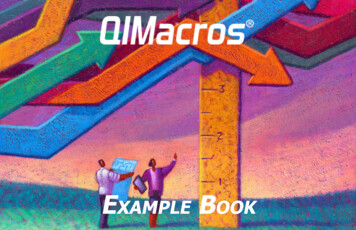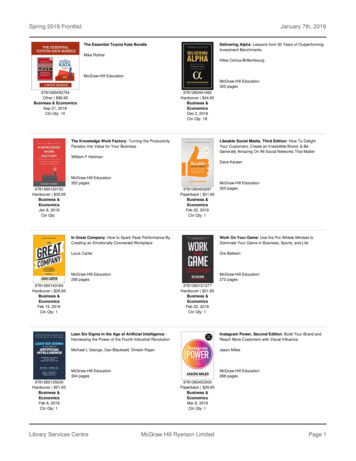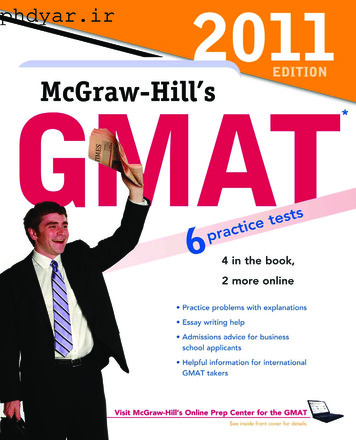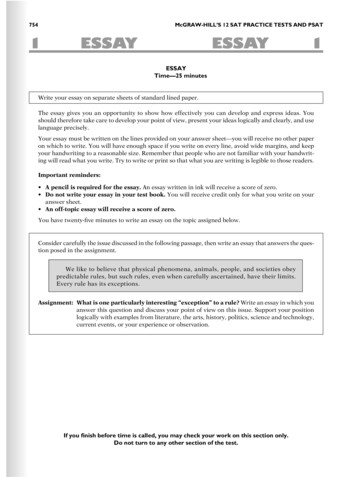
Transcription
754McGRAW-HILL’S 12 SAT PRACTICE TESTS AND PSAT1ESSAYESSAY1ESSAYTime—25 minutesWrite your essay on separate sheets of standard lined paper.The essay gives you an opportunity to show how effectively you can develop and express ideas. Youshould therefore take care to develop your point of view, present your ideas logically and clearly, and uselanguage precisely.Your essay must be written on the lines provided on your answer sheet—you will receive no other paperon which to write. You will have enough space if you write on every line, avoid wide margins, and keepyour handwriting to a reasonable size. Remember that people who are not familiar with your handwriting will read what you write. Try to write or print so that what you are writing is legible to those readers.Important reminders: A pencil is required for the essay. An essay written in ink will receive a score of zero. Do not write your essay in your test book. You will receive credit only for what you write on youranswer sheet. An off-topic essay will receive a score of zero.You have twenty-five minutes to write an essay on the topic assigned below.Consider carefully the issue discussed in the following passage, then write an essay that answers the question posed in the assignment.We like to believe that physical phenomena, animals, people, and societies obeypredictable rules, but such rules, even when carefully ascertained, have their limits.Every rule has its exceptions.Assignment: What is one particularly interesting “exception” to a rule? Write an essay in which youanswer this question and discuss your point of view on this issue. Support your positionlogically with examples from literature, the arts, history, politics, science and technology,current events, or your experience or observation.If you finish before time is called, you may check your work on this section only.Do not turn to any other section of the test.
PRACTICE TEST 12755222222SECTION 2Time—25 minutes20 questionsTurn to Section 2 of your answer sheet to answer the questions in this section.Directions: For this section, solve each problem and decide which is the best of the choices given. Fill inthe corresponding circle on the answer sheet. You may use any available space for scratchwork.1. The use of a calculator is permitted.Notes2. All numbers used are real numbers.3. Figures that accompany problems in this test are intended to provide information useful in solving the problems. They are drawn as accurately as possible EXCEPT when it is stated in a specific problem that the figure is not drawn to scale. All figures lie in a plane unless otherwiseindicated.Reference Information4. Unless otherwise specified, the domain of any function f is assumed to be the set of all real numbers x for which f(x) is a real number.1.ᐉrrwhhch b2xwA ᐉwπr2A C 2πrbA 1/2 bhᐉV ᐉwhV aa2 b2πr 2hc2 60 45 s 2xs30 s45 x 3Special right trianglesThe number of degrees of arc in a circle is 360.The sum of the measures in degrees of the angles of a triangle is 180.A playground with an area of 3,600 square feetis to be divided into six different play stations.What is the average (arithmetic mean) area, insquare feet, of the six stations?(A)(B)(C)(D)(E)4005006007008002.If 3a 15 and 4b 10, what is the value of a ?b(A)(B)(C)(D)(E)122332252GO ON TO THE NEXT PAGE
756McGRAW-HILL’S 12 SAT PRACTICE TESTS AND PSAT222222Salary(in thousands of dollars)SALARIES AT ULTRACORP403530Employee 1Employee 5204.One bucket of fried chicken serves either threeadults or five children. If the Memorial Dayfair committee wants to have enough chickento serve 100 children and 60 adults, how manybuckets of chicken are needed?(A)(B)(C)(D)(E)5.Employee 1Employee 2Employee 3Employee 4Employee 52932354045(5x 3x 4)(3x 6x 2) (A)(B)(C)(D)(E)a b c z d m25lNote: Figure not drawn to scale.6.In the figure above, l m and z 55. What is thevalue of a b c?(A)(B)(C)(D)(E)The graph above shows the salaries of five employees at UltraCorp over an eight-year period.Which employee’s salary has risen at thefastest rate over this period?(A)(B)(C)(D)(E)x y Employee 3Employee 41992 1994 1996 1998 2000Year3.w Employee 27.If 7 x 16 79 , what is the value of x?(A)(B)(C)(D)(E)8.2352652753053153692781Each term in a sequence of numbers, exceptfor the first term, is 2 less than the square rootof the previous term. If the third term of thissequence is 1, what is the first term?(A)(B)(C)(D)(E)19111211239x2 16x 418x2 32x 818x2 40x 872x2 20x 872x2 20x 8GO ON TO THE NEXT PAGE
PRACTICE TEST 12275722ABx, y, 3y12.If the average (arithmetic mean) of the threenumbers above is 3x and x 0, what is y interms of x?x22x3xx 73x 3(A)D9.(B)(C)(D)(E)CIn the figure above, rectangle ABCD has anarea of 90 and is divided into 15 smallersquares. What is the sum of the areas of theshaded regions?(A)(B)(C)(D)(E)3942454851For all x greater than 2, letbe definedas the sum of the positive integers less than x.What is the value of(A)(B)(C)(D)(E) 13.?1,33XIn the correctly worked addition problemabove, X and Y represent two different digits.What digit does X represent?(A)(B)(C)(D)(E)( y 1) In the figure above, what is the value of x interms of w?(A)(B)(C)(D)(E)2729424554X3Y 5YXx w Note: Figure not drawn to scale.14.11.(z-1) z y 10.222w 2w 1ww 1w 2When r is divided by 10, the remainder is 9. Whatis the remainder when r 2 is divided by 5?(A)(B)(C)(D)(E)01341401489GO ON TO THE NEXT PAGE
758McGRAW-HILL’S 12 SAT PRACTICE TESTS AND PSAT215.22If five distinct lines lie in a plane, then at mosthow many distinct points can lie on two ormore of these lines?(A)(B)(C)(D)(E)222VW50 678910UXYT16.A pile of playing cards consists of only kings,jacks, and queens. If the probability of ran-Note: Figure not drawn to scale.17.1domly choosing a king isand the proba42bility of randomly choosing a queen is,7what is the probability of randomly choosinga jack?(A)37(B)1328(C)1528(D)47(E)914In the figure above, ΔVXT is equilateral andWU WY. If the measure of VWU is twice themeasure of VUW, what is the measure of TUY?(A)(B)(C)(D)(E)18.55 60 65 70 75 If m and n are positive numbers, whatpercent of m 4 is n 2?(A)(B)(C)(D)(E)100 (n 2)%(m 4)m 4(100) %n 2100 n 2%(m 4)m 4%100 nn 2%m 4GO ON TO THE NEXT PAGE
PRACTICE TEST 12275922h(t) 5t2 120t m19.20.At time t 0, a rocket was launched from aplatform m meters above the ground. Until therocket hit the ground, its height, in meters,after t seconds was given by the function habove. For which of the following values of tdid the rocket have the same height as it didwhen t 10?(A)(B)(C)(D)(E)812141618STOP222The price of a certain stock was d dollars onJanuary 1, 2003. The price decreased by 20%in January, increased by 40% in February, decreased by 25% in March, and increased by25% in April. In terms of d, what was the priceof the stock at the end of April?(A)(B)(C)(D)(E)0.80d0.84d1.05d1.12d1.20dIf you finish before time is called, you maycheck your work on this section only. Do notturn to any other section of the test.
760McGRAW-HILL’S 12 SAT PRACTICE TESTS AND PSAT333333SECTION 3Time—25 minutes24 questionsTurn to Section 3 of your answer sheet to answer the questions in this section.Directions: For each question in this section, select the best answer from among the choices given andfill in the corresponding circle on the answer sheet.Each sentence below has one or two blanks,each blank indicating that something has beenomitted. Beneath the sentence are five wordsor sets of words labeled A through E. Choosethe word or set of words that, when insertedin the sentence, best fits the meaning of thesentence as a whole.2.Decades of political ------- have left the regionon the brink of war; the slightest ------- couldcause it to explode into destructive conflict.(A)(B)(C)(D)(E)dissension . . constructtension . . communicationharmony . . instigationstrife . . provocationunanimity . . agitationEXAMPLE:Rather than accepting the theory unquestioningly, Deborah regarded it with gnoranceskepticism(A)(B)(C)(D)(E)A B C D E4.1.Jacques Lugard’s world-renowned 34th-Streetbistro is known best for its ------- main courses,but many go there simply to enjoy the restaurant’s ------- desserts.(A)(B)(C)(D)(E)delectable . . scrumptiousunpalatable . . tantalizingdivine . . blanddebilitating . . uninspiredsavory . . mediocreFor over 500 years, the smile on the Mona Lisahas been the source of much ------- among arthistorians, who continue to interpret her enigmatic expression in many different nciliationEven after his death, Elvis Presley continues tobe one of the most ------- singers of all time;every year hundreds of thousands of fanstravel to his hometown to pay tribute to despisedshunnedGO ON TO THE NEXT PAGE
PRACTICE TEST 1235.3an eyesore . . adversaryan enhancement . . gratuityan embellishment . . windfalla defacement . . calamityan atrocity . . boonNineteenth-century author Edgar Allen Poewas acclaimed for his ------- inventiveness; hehad an unmatched ability to write ------- talesof cruelty and torture that mesmerized ebraltransparentoutlandishDetractors of the new building say that it is------- aesthetically and furthermore that, farfrom being the financial ------- that its developers claimed it would be, the project has costthe city dearly in lost revenue.(A)(B)(C)(D)(E)7.3Professional poker player Howard Lederer isknown as “the professor” because of the ------tactics he uses to outthink his opponents.(A)(B)(C)(D)(E)6.761tenuous . . spellbindinggrotesque . . enthrallinginterminable . . sacrilegiouseclectic . . sadisticchimerical . . mundaneDNA evidence taken from the scene of thecrime was used to ------- the defendant; thegenomic “fingerprint” taken from the bloodsample was not a match for the accused, thusproving his inateexculpateequivocateThe passages below are followed by questionsbased on their content. Answer the questionson the basis of what is stated or implied in thepassage and in any introductory material thatmay be provided.333Questions 9 and 10 are based on the following passage.Line51015209.Debussy, though less radical harmonicallythan Schoenberg, preceded him in startingthe breakdown of the old system. Debussy,one of the most instinctive musicians whoever lived, was the first composer of our timewho dared to make his ear the sole judge ofwhat was good harmonically. With Debussy,analysts found chords that could no longer beexplained according to the old harmony. Ifone had asked Debussy why he used suchchords, I am sure he would have given theonly possible answer: “I like it that way!” Itwas as if one composer finally had confidencein his ear. I exaggerate a little, for, after all,composers have never had to wait for theoreticians to tell them what or what not to do.On the contrary, it has always been the otherway about—theoreticians have explained thelogic of the composer’s thought after he hasinstinctively put it down.It can be inferred from the passage that the“old system” (line 3) most likely involved(A)(B)(C)(D)(E)a way of developing musical intuitiona rigid method for writing musicalharmoniesa means by which musicians couldincorporate the ideas of theoreticiansinto their musica method of transcribing music thatarose spontaneously from a musician’simaginationmethods that theoreticians used fordistinguishing the harmonies ofdifferent composersFirst passage: What to Listen for in Music, Aaron Copland,McGraw-Hill, 1957. Reprinted with permission of the AaronCopland Fund for Music, Inc., Copyright owner.Second passage: The Oceans, Ellen J. Prager; McGraw-Hill,2000. Reprinted with permission of The McGraw-HillCompanies.GO ON TO THE NEXT PAGE
762McGRAW-HILL’S 12 SAT PRACTICE TESTS AND PSAT310.33The passage characterizes Debussy primarilyas being(A)(B)(C)(D)(E)312.(A)(B)(C)(D)Questions 11 and 12 are based on the following passage.Line51015202511.The passage describes a trip in a hot-air balloon primarily in order to(A)(B)(C)(D)(E)describe the variety of life forms in therainforestmake an analogy to ocean explorationexemplify the advanced equipment thatland-based biologists have at their disposalshow the difficulties that most biologistsencounter in extracting samples from therainforestdemonstrate how methods of biologicalexploration have evolved over time3The “small-scale chemical and biological measures” (lines 20–21) are mentioned primarilyas examples ofless self-assured than other composers ofhis timereverential of traditional musical formspreoccupied more with musical theorythan with practiceharmonically inventivederisive of musical theoreticiansImagine flying in a hot-air balloon over thelush, green canopy of a rainforest. Throughthe clouds and mist you can barely make outthe treetops and a few of the birds flyingamong them. What lies hidden in the undergrowth? How many organisms are there, whatdo they look like, and how do they behave?Using a rope and bucket you blindly drag therainforest from above hoping to ensnare someof its inhabitants or the materials that makeup its infrastructure. But alas, with such feeble and limited means you can learn littleabout the environment and life below. Foryears this is essentially how we have studiedthe ocean—blindly sampling the sea with limited and relatively ineffective methods. Eventoday, with technology as advanced as it is,study of the ocean remains a difficult and expensive task. Whether through large-scalesatellite imagery, small-scale chemical and biological measures, or even the collecting offossil impressions of ancient sea creatures, allaspects of oceanographic study require sometype of observation or sample collection, andherein lies the problem.3(E)methods that are not as cost-effective orsimple as the author would likechallenges for the explorer of therainforesttechnologies that hold great promise forrevealing the nature of oceanic lifetechniques that require little or no training to employinexpensive means of exploring the deepest parts of the oceanQuestions 13–17 are based on the following passage.The following is an excerpt from a book aboutthe history of primitive art.Line5101520Pictures from the earliest artistic periodsare the traces of a primal concept of theworld. In spite of the thematic treatment ofreal creatures we can still recognize, paintingsof animals or men from the early Stone Ageare charged with magical strength, exaggerated and concentrated as they are into formsof existential experience. They fulfilled stillother functions beyond the mere representation of the visible.The degree of naïveté in archaic primitiveart varies. A certain naïveté is always presentwhen observation of nature is not overlaidwith rational thought. Art first had to discoverthe world and to invent ways of making it perceivable. Along with visible things, invisibleforces too were given form and substance andbegan to make their appearance. And as theyachieved form they took on permanence.The early hunters attempted to influencethe chance fortunes of the hunt through magical practices. The power of magic was as realto them as the power of the stone ax they hadinvented. Art ensnared the form of the animal.GO ON TO THE NEXT PAGE
PRACTICE TEST 1237633325 Whenever the figure of woman appears it is asign of fertility; representations of men arerarer, and when they occur they show him inhis role as hunter. Man does not yet look beyond the borders of existence that mark his30 practical life. Magic precedes the fall of maninto knowledge.It must have meant a considerable revolution in prehistoric times when man discovered that he did not have to live solely from35 hunting, that not only the animals but indeedall of nature round about him was full of life.Stars and seasons take their rhythms from unknown forces; a mysterious power functioningbeyond human understanding, propitious or40 forbidding, helpful or threatening; forces ofancestors, spirits, and demons, and forces ofthe departed and the coming gods.With the transition from the early to thelate Stone Age there appears the first stylistic45 change in art. The original naturalism basedon observation and experience gives way to ageometrically stylized world of forms discoverable only through thought and speculation.Prehistoric man, leaving behind him the50 life of the hunter and gatherer, invents abbreviations and pictographic signs which are nolonger pictures proper but rather thoughtmodels, reflections of his more settled existence as a beginning herdsman and farmer.Following the late Stone Age, the art of the55Bronze Age—which in Asia dates from the middle of the third millennium B.C. and whichbegan in Europe around 2100 B.C.—contains,as does the art of the Iron Age as well, elements60 of naïveté and inventive immediacy side by sidewith highly developed, formalized compositions. The bronze sculptures of the Celts andthe Illyrians are ample witnesses to them.With the substitution of conceptual ratio65 nalization for more primitive, mythical explanations of the world, a kind of art arises inwhich objective criteria of reality and the natural laws of optics come into play. The simplicity and vividness of the naïve become70 more rare.The art of the period of the catacombs wasinformed with the naturalistic naïveté of lateantiquity. In medieval Christian art, whichMasters of Naïve Art, Oto Bihalji-Merin. Reprinted withpermission of The McGraw-Hill Companies.333was averse to any spatial illusions, a “moral”75 perspective dominated; all action was pressedonto the holy, two-dimensional surface.While the primitive and instinctual accompanies the course of art until the Renaissance, itrecedes in the face of the humanistic concept of80 the world and the discovery of linear and aerialperspective. High art forsakes the realm of instinct in exchange for the province of reason.But parallel with it, in folk art and amongso-called primitive peoples, naïve representa85 tion lives on.13.The first paragraph suggests that the “primalconcept of the world” (lines 2–3) involved(A)(B)(C)(D)(E)14.In line 6, the word “charged” most nearly means(A)(B)(C)(D)(E)15.a belief that art was more importanteven than huntinga need to preserve a record of events forthe futurea focus on the realistic depiction ofanimalsa sense that paintings can have powersbeyond what can be seena desire to communicate with animalsexchangedapproached violentlyaccusedtrampledfilledThe “stylistic change” (lines 44–45) is a transition from(A)(B)(C)(D)(E)representations of real things to representations of ideasmagical applications of art to representations of hunting scenesdepictions of gods to depictions ofherdsmenart used to depict the natural environment to art used for magical ritualsa focus on the theme of hunting to afocus on the theme of fertilityGO ON TO THE NEXT PAGE
764McGRAW-HILL’S 12 SAT PRACTICE TESTS AND PSAT316.3The “bronze sculptures of the Celts and theIllyrians” (lines 62–63) are mentioned primarilyas examples of(A)(B)(C)(D)(E)17.3a new appreciation of three-dimensional artart with both primitive and formalcharacteristicsa revival of the art of the Stone Ageillustrations of the herding lifeart with moralistic themesThe passage indicates that, unlike the “art ofthe period of the catacombs” (line 71), Renaissance art is characterized by(A)(B)(C)(D)(E)an appreciation of three-dimensional formsan emphasis on religious themesrepresentations of magical creaturesa primitive view of the worlda focus on the realm of instinct330354045Questions 18–24 are based on the following passage.The following passage, from a modern textbook onanthropology, discusses a debate among biologistsand anthropologists about how humans evolved.Does evolution occur gradually or in “punctuated equilibria”? Charles Darwin, a gradualLine ist, maintained that life forms arise fromothers in a gradual and orderly fashion. Small5 modifications that accumulate over the generations add up to major changes after millionsof years. Gradualists cite intermediate fossilsas evidence for their position, contending thatthere would be even more transitional forms10 if it weren’t for gaps in the fossil record.The advocates of the punctuated equilibrium model believe that long periods of equilibrium, during which species change little,are interrupted (punctuated) by sudden15 changes—evolutionary leaps. One reason forsuch jumps in the fossil record may be extinction followed by invasion by a closely relatedspecies. For example, a sea species may die outwhen a shallow body of water dries up, while a20 closely related species will survive in deeperwaters. Then, later, when the sea reinvades thefirst locale, the protected species will extend itsrange to the first area. Another possibility isthat when barriers are removed, a group may25 replace, rather than succeed, a related one because it has a trait that makes it adaptively superior in the environment they now share.505560657033When a major environmental change occurssuddenly, one possibility is for the pace of evolution to increase. Another possibility is extinction. The earth has witnessed several massextinctions—worldwide ecosystem catastrophes that affect multiple species. Thebiggest one divided the era of “ancient life” (thePaleozoic) from the era of “middle life” (theMesozoic). This mass extinction occurred 245million years ago, when 4.5 million of theearth’s estimated 5 million species (mostly invertebrates) were wiped out. The secondbiggest extinction, which occurred 65 millionyears ago, destroyed the dinosaurs and manyother Mesozoic species. One explanation forthe extinction of the dinosaurs is that a massive, long-lasting cloud of gas and dust arosefrom the impact of a huge meteorite. The cloudblocked solar radiation and therefore photosynthesis, ultimately destroying most plantsand the chain of animals that fed on them.The hominid fossil record exemplifies bothgradual and rapid change, confirming thatevolution can be faster or slower dependingon the rate of environmental change, thespeed with which geographic barriers rise orfall, and the value of the group’s adaptive response. Australopithecine teeth and skullsshow some gradual transitions. For example,some of the fossils that are intermediate between Australopithecus and early Homo combine a larger brain (characteristic of Homo)with huge back teeth and supportive structures(characteristic of the australopithecines). However, there is no doubt that the pace of hominidevolution sped up around 18 million years ago.This spurt resulted in the emergence (in just200,000 years) of Homo erectus. This was followed by a long period of relative stability. Theprobable key to the rapid emergence of Homoerectus was a dramatic change in adaptivestrategy: greater reliance on hunting throughimproved tools and other cultural means ofadaptation. The new economy, tools, and phenotype arose and spread rapidly, then remained fairly stable for about 1 million years.Anthropology: The Exploration of Human Diversity, Conrad PhillipKottak, McGraw-Hill. Reprinted with permission of TheMcGraw-Hill Companies.GO ON TO THE NEXT PAGE
PRACTICE TEST 12318.3(B)(C)(D)(E)(B)(C)(D)(E)22.(C)(D)(E)23.the differences between the demandsof an aquatic environment and thedemands of a terrestrial environmenthow the fossil record can misrepresentthe history of a speciesthe manner in which one species gradually evolves into a more advanced onea current theory of how mass extinctionsoccurhow punctuated evolution can occur(D)(E)they were struck by a large meteoritetheir food supply was eliminateda more dominant species invaded theirenvironment and destroyed themthe earth’s temperature increased dramatically after the impact of a meteoritea sudden ice age destroyed theirenvironment(C)(D)(E)providing evidencesecondaryemotionally STOPwas no longer dominated by the dinosaurswas characterized by the rise of Homoerectuswas characterized by a greater diversityof life than that in the late Paleozoic erawas far colder than the late Paleozoic eracontained far fewer species than the latePaleozoic era didAustralopithecus developed a larger brainHomo erectus developed better means ofhunting and social interactionHomo erectus invaded and took over theenvironment of AustralopithecusAustralopithecus developed large teeth,which enabled it to eat a wider variety offoodsa natural catastrophe, perhaps a meteor,destroyed many species that were competing with the hominidsGiven the information in the passage as awhole, how would the author most likely answer the opening question of the passage?In line 60, “supportive” most nearly means(A)(B)(C)(D)(E)3According to the passage, “the pace of hominidevolution sped up around 18 million yearsago” (lines 62–63) most likely because(A)(B)24.3According to the passage, the early Mesozoicera differed from the late Paleozoic era chieflyin that the early Mesozoic era(A)(B)According to the passage, the dinosaurs mostlikely became extinct because(A)(B)(C)21.3how some species have come todominate othershow life first arose on earththe gradual nature of evolutionthe divisions in the scientific communityover the manner in which evolution occurshow barriers arise between speciesThe example of the two “sea species” (line 18)described in the second paragraph is intendedto demonstrate(A)20.3The passage suggests that the existence of“transitional forms” (line 9) would demonstrate(A)19.765The gaps in the fossil record indicateclearly that all organisms evolve in punctuated equilibrium.The example of Homo erectus demonstrates that no species can remain stablefor very long.The rapidity with which species evolvedepends on many factors, so evolution canoccur gradually or in a punctuated manner.Only occasional mass extinctions interrupt the gradual evolution of species.The father of evolution, Charles Darwin,was correct in believing that all speciesevolve gradually over long periods of time.If you finish before time is called, you maycheck your work on this section only. Do notturn to any other section of the test.
766McGRAW-HILL’S 12 SAT PRACTICE TESTS AND PSAT444444SECTION 4Time—25 minutes35 questionsTurn to Section 4 of your answer sheet to answer the questions in this section.Directions: For each question in this section, select the best answer from among the choices given andfill in the corresponding circle on the answer sheet.The following sentences test correctness andeffectiveness of expression. Part of each sentence or the entire sentence is underlined;beneath each sentence are five ways of phrasing the underlined material. Choice A repeatsthe original phrasing; the other four choicesare different. If you think the original phrasingproduces a better sentence than any of thealternatives, select choice A; if not, select oneof the other choices.In making your selection, follow the requirements of standard written English; that is, payattention to grammar, choice of words, sentenceconstruction, and punctuation. Your selectionshould result in the most effective sentence—clear and precise, without awkwardness orambiguity.EXAMPLE:The children couldn’t hardly believe their eyes.(A)(B)(C)(D)(E)couldn’t hardly believe their eyescould hardly believe their eyeswould not hardly believe their eyescouldn’t nearly believe their eyescouldn’t hardly believe his or her eyes1.Renowned for his skills on the trumpet, LouisArmstrong also thrilling listeners with hisremarkable and unique singing voice.(A)(B)(C)(D)(E)2.thrilling listeners with his remarkableand unique singing voicethrilled listeners with his remarkable andunique singing voicewith his remarkable and unique singingvoice thrilled listenersthrilled listeners remarkably with hissinging voice that was uniquethrilling listeners, his remarkable andunique singing voiceLike children, cats often develop a love for certain toys, creating games and diversions thatcan occupy them for hours.(A)(B)(C)(D)(E)toys, creating games and diversionstoys and creating games and divertingtoys and in creating games anddiversionstoys; and these create games anddiversionstoys, the creation of games anddiversionsA B C D EGO ON TO THE NEXT PAGE
PRACTICE TEST eving his speech to be superior to theother candidatesBelieving his speech superior to theother candidatesOf the belief that his speech was superiorto the other candidatesBelieving his speech to be superior tothose of the other candidatesOf the belief that his speech was superiorover the other candidatesUndeterred by her parents’ opposition, Rachelchanged her major from economics to Frenchliterature.(A)(B)(C)(D)(E)(B)Undeterred by her parents’ oppositionUndeterred with the opposition of herparentsUndeterred in that her parents opposed herHer parents’ opposition, which did notdeter herBeing undeterred that her parentsopposed her(C)(D)(E)as well as lacking discipline andbecoming demoralizedlacking discipline, and becomingdemoralizedundisciplined, and demoralizedbeing undisciplined and demoralizedwere undisciplined, and weredemoralizedrather their ability to memorize and usea set of test-taking tricksinstead it tests your ability to memorizeand use test-taking tricksalso the ability to memorize and use a setof test-taking tricksrather the ability to memorize and use aset of test-taking tricksinstead the ability of memorizing andusing a set of test-taking tricksMuhammad Ali, known almost as much for hiscontroversies outside the ring as for his glorywithin it, becoming a great American icon.(A)(B)(C)(D)(E)10.4Standardized tests, some argue, do not indicatea student’s academic skill but rather their abilityto memorize and use a set of test-taking tricks.(A)9.4The field commanders felt that they were losing control of their troops, who w
758 McGRAW-HILL’S 12 SAT PRACTICE TESTS AND PSAT 2 2 222 2 GO ON TO THE NEXT PAGE 15. If five distinct lines lie in a plane, then at most how many distinct points can lie on two or more of these lines? (A) 6 (B) 7 (C) 8 (D) 9 (E) 10 16. A pile of playing cards consists of

